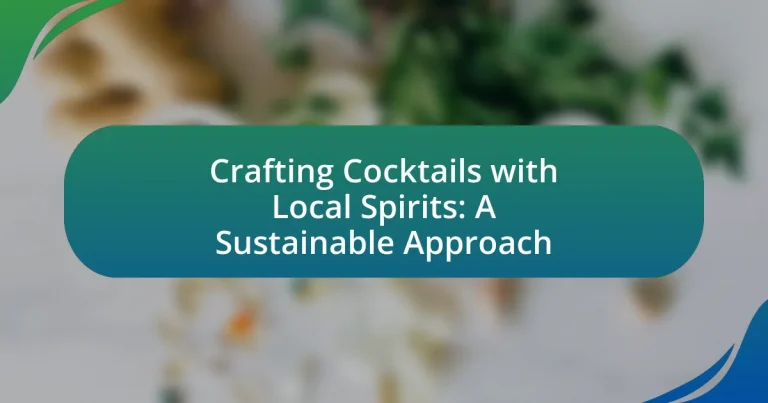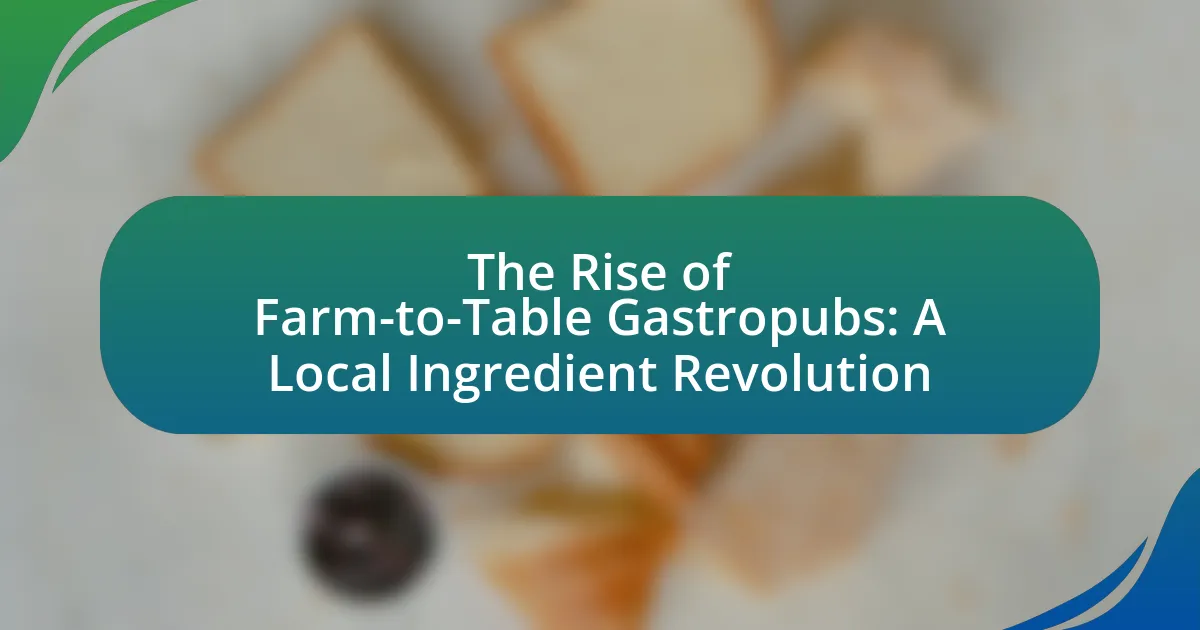Crafting cocktails with local spirits emphasizes the use of regionally produced alcoholic beverages, promoting sustainability and supporting local economies. This article explores how local spirits enhance flavor profiles, reflect regional identity, and contribute to environmentally responsible practices in cocktail crafting. It discusses the characteristics of local spirits, the importance of using seasonal ingredients, and best practices for minimizing waste. Additionally, the article addresses the challenges and misconceptions surrounding local spirits and sustainability, providing practical tips for bartenders and consumers to create innovative and eco-friendly cocktails.

What is Crafting Cocktails with Local Spirits?
Crafting cocktails with local spirits involves creating mixed drinks using alcoholic beverages produced in the same region as the cocktail itself. This practice emphasizes the use of locally sourced ingredients, which supports regional distilleries and promotes sustainability by reducing transportation emissions. For example, using a gin made from locally grown botanicals not only enhances the flavor profile of the cocktail but also fosters a connection to the local community and its agricultural practices.
How does the use of local spirits influence cocktail crafting?
The use of local spirits significantly influences cocktail crafting by enhancing flavor profiles and promoting regional identity. Local spirits often reflect the unique ingredients and traditions of their area, allowing bartenders to create cocktails that resonate with local culture and taste preferences. For instance, using locally distilled gin can introduce botanicals native to the region, resulting in a distinct flavor that cannot be replicated with mass-produced alternatives. This practice not only supports local economies but also encourages sustainable sourcing, as it reduces transportation emissions associated with importing spirits. Additionally, cocktails made with local spirits can attract customers seeking authentic experiences, thereby fostering a deeper connection between the drinker and the locale.
What are the characteristics of local spirits that enhance cocktails?
Local spirits enhance cocktails through their unique flavor profiles, regional ingredients, and cultural significance. These spirits often incorporate local botanicals, fruits, or grains, which contribute distinct tastes that can elevate a cocktail’s complexity. For example, a gin made with locally sourced herbs can provide a fresh, aromatic quality, while a whiskey aged in regional barrels may impart unique notes of vanilla or spice. Additionally, local spirits often reflect the traditions and craftsmanship of their region, adding a narrative element to the cocktail experience. This connection to place not only enriches the flavor but also promotes sustainability by supporting local agriculture and distilling practices.
How do local ingredients contribute to flavor profiles in cocktails?
Local ingredients significantly enhance flavor profiles in cocktails by introducing unique, region-specific tastes and aromas. These ingredients, such as locally sourced fruits, herbs, and spices, reflect the terroir of the area, providing a distinct character that cannot be replicated with imported components. For example, using fresh citrus from a nearby orchard can impart vibrant acidity and freshness, while local herbs like basil or mint can add aromatic complexity. Studies show that cocktails made with local ingredients often receive higher ratings for taste and originality, as they resonate more with consumers’ preferences for authenticity and sustainability. This connection to local agriculture not only enriches the drinking experience but also supports local economies and promotes sustainable practices in the beverage industry.
Why is sustainability important in cocktail crafting?
Sustainability is important in cocktail crafting because it minimizes environmental impact and promotes responsible sourcing of ingredients. By using local spirits and seasonal produce, bartenders reduce carbon footprints associated with transportation and support local economies. Research indicates that sustainable practices in the beverage industry can lead to a 30% reduction in waste and a significant decrease in water usage, highlighting the tangible benefits of eco-friendly approaches.
What are the environmental impacts of using local spirits?
Using local spirits can have positive environmental impacts, primarily by reducing carbon footprints associated with transportation. When spirits are produced and consumed locally, the need for long-distance shipping is minimized, which decreases greenhouse gas emissions. Additionally, local distilleries often utilize regional ingredients, promoting sustainable agricultural practices and supporting local economies. For instance, a study by the University of California found that local sourcing can reduce transportation emissions by up to 50%. Furthermore, local production often involves smaller-scale operations that may implement eco-friendly practices, such as waste reduction and water conservation, further enhancing their sustainability profile.
How does supporting local distilleries promote sustainability?
Supporting local distilleries promotes sustainability by reducing transportation emissions and fostering local economies. When consumers choose spirits produced nearby, they minimize the carbon footprint associated with long-distance shipping. Additionally, local distilleries often source ingredients from regional farmers, which supports sustainable agricultural practices and strengthens community ties. This localized approach not only conserves resources but also encourages responsible production methods, as smaller distilleries are more likely to prioritize environmental stewardship.
What are the key principles of sustainable cocktail crafting?
The key principles of sustainable cocktail crafting include using local ingredients, minimizing waste, and prioritizing eco-friendly practices. By sourcing fruits, herbs, and spirits from local producers, bartenders support regional economies and reduce carbon footprints associated with transportation. Additionally, minimizing waste involves utilizing every part of an ingredient, such as using citrus peels for garnishes or infusions, which enhances flavor while reducing disposal. Eco-friendly practices, such as using biodegradable straws and sustainable glassware, further contribute to environmental responsibility in cocktail crafting. These principles collectively promote a more sustainable approach to mixology, aligning with growing consumer demand for environmentally conscious choices.
How can bartenders incorporate seasonal ingredients into cocktails?
Bartenders can incorporate seasonal ingredients into cocktails by sourcing fresh produce, herbs, and spices that are at their peak during specific times of the year. For example, using strawberries in spring, peaches in summer, apples in fall, and citrus fruits in winter allows bartenders to create vibrant and flavorful drinks that reflect the season. This practice not only enhances the taste and presentation of cocktails but also supports local agriculture and reduces carbon footprints associated with transporting out-of-season ingredients. Seasonal ingredients often have higher nutritional value and better flavor profiles, making cocktails more appealing to customers.
What practices can reduce waste in cocktail preparation?
Practices that can reduce waste in cocktail preparation include using fresh ingredients efficiently, repurposing byproducts, and implementing portion control. Efficient use of fresh ingredients minimizes spoilage; for example, utilizing citrus peels in syrups or garnishes can enhance flavor while reducing waste. Repurposing byproducts, such as using leftover fruit from juicing in cocktails or as garnishes, further decreases waste. Implementing portion control ensures that ingredients are measured accurately, preventing over-pouring and excess waste. These practices not only contribute to sustainability but also enhance the overall cocktail experience.
How can consumers engage with local spirits in cocktail crafting?
Consumers can engage with local spirits in cocktail crafting by sourcing ingredients from nearby distilleries and incorporating regional flavors into their drinks. This practice not only supports local economies but also enhances the authenticity of cocktails by using spirits that reflect the unique characteristics of the area. For example, using a locally produced gin infused with local botanicals can create a distinct flavor profile that showcases the region’s agricultural heritage. Engaging with local spirits also allows consumers to participate in tasting events and workshops hosted by distilleries, fostering a deeper understanding of the production process and the nuances of different spirits.
What are the benefits of choosing local spirits for home bartending?
Choosing local spirits for home bartending enhances the quality and sustainability of cocktails. Local spirits often feature unique flavors that reflect regional ingredients and traditions, providing a distinct taste experience. Additionally, sourcing spirits locally reduces transportation emissions, supporting environmental sustainability. According to a study by the American Distilling Institute, local distilleries contribute to the economy by creating jobs and fostering community engagement, which further emphasizes the benefits of supporting local producers.

What types of local spirits can be used in cocktails?
Local spirits that can be used in cocktails include whiskey, rum, gin, vodka, and tequila, each offering unique flavors and characteristics. For instance, American whiskey, particularly bourbon, is known for its rich, sweet profile, while local rums can provide a tropical sweetness, often derived from sugarcane. Gin, especially those infused with local botanicals, adds aromatic complexity, and vodka serves as a versatile base for various cocktails. Tequila, particularly from specific regions in Mexico, contributes a distinct agave flavor. These spirits not only enhance the cocktail experience but also support local economies and sustainable practices by sourcing ingredients locally.
How do different types of local spirits vary in flavor and use?
Different types of local spirits vary significantly in flavor and use due to their unique ingredients, production methods, and cultural contexts. For example, mezcal, primarily produced in Mexico, has a smoky flavor derived from the agave plant being roasted in underground pits, making it suitable for sipping or in cocktails that require a robust taste. In contrast, sake from Japan is brewed from rice and has a delicate, slightly sweet flavor profile, often enjoyed warm or chilled, and is commonly used in traditional ceremonies and paired with food. Additionally, whiskey, particularly Scotch, offers a wide range of flavors from peaty to fruity, depending on the region and aging process, and is frequently used in classic cocktails like the Old Fashioned. These variations illustrate how local spirits not only reflect their geographical origins but also influence the way they are consumed in different cultural settings.
What are the most popular local spirits in various regions?
The most popular local spirits vary by region, reflecting cultural traditions and local ingredients. In Mexico, tequila and mezcal are prominent, with tequila being made from blue agave and mezcal from various agave species. In Scotland, whisky, particularly single malt Scotch, is highly regarded, with regions like Islay known for their peaty flavors. In Russia, vodka is the national spirit, traditionally distilled from grains or potatoes. In Brazil, cachaça, made from fermented sugarcane juice, is essential for cocktails like caipirinha. In Japan, shochu, a distilled spirit made from barley, sweet potatoes, or rice, is popular. Each of these spirits is deeply rooted in the local culture and production methods, showcasing the diversity of global alcoholic beverages.
How can unique local spirits inspire innovative cocktail recipes?
Unique local spirits can inspire innovative cocktail recipes by introducing distinct flavors and cultural narratives that enhance mixology creativity. For instance, spirits like mezcal from Mexico offer smoky notes that can transform traditional cocktails, while local gins infused with regional botanicals provide unique aromatic profiles. The incorporation of these spirits allows bartenders to experiment with new flavor combinations, leading to the creation of signature cocktails that reflect local heritage. Additionally, using local ingredients in conjunction with these spirits fosters a sustainable approach, as it supports local agriculture and reduces carbon footprints associated with transportation. This practice not only elevates the cocktail experience but also promotes community engagement and appreciation for local craftsmanship.
What role do local mixers and garnishes play in cocktail crafting?
Local mixers and garnishes are essential in cocktail crafting as they enhance flavor profiles and contribute to the overall sensory experience. By incorporating locally sourced ingredients, bartenders can create unique cocktails that reflect regional tastes and traditions. For instance, using local fruit juices or herbs can introduce fresh, vibrant flavors that elevate the drink’s complexity. Additionally, local garnishes, such as herbs or edible flowers, not only add visual appeal but also complement the cocktail’s aroma and taste. This practice supports local agriculture and promotes sustainability, aligning with the growing trend of farm-to-table concepts in the beverage industry.
How can local fruits and herbs enhance cocktail flavors?
Local fruits and herbs enhance cocktail flavors by providing unique, fresh, and vibrant taste profiles that reflect regional characteristics. The incorporation of local ingredients allows for the creation of cocktails that are not only flavorful but also sustainable, as they reduce the carbon footprint associated with transporting ingredients. For example, using locally sourced citrus fruits can add brightness and acidity, while herbs like basil or mint can introduce aromatic complexity. Studies have shown that fresh ingredients can significantly elevate the sensory experience of cocktails, making them more appealing to consumers.
What are some examples of local mixers that pair well with spirits?
Examples of local mixers that pair well with spirits include fresh fruit juices, artisanal sodas, and herbal infusions. Fresh fruit juices, such as orange, lime, or grapefruit, enhance the flavor profile of spirits like vodka or gin. Artisanal sodas, often made with local ingredients, provide unique flavor combinations that complement whiskey or rum. Herbal infusions, such as basil or mint, can elevate cocktails by adding aromatic complexity, making them ideal mixers for various spirits. These mixers not only enhance the taste but also support local producers, aligning with sustainable practices in cocktail crafting.

How can bartenders and consumers create sustainable cocktails?
Bartenders and consumers can create sustainable cocktails by prioritizing local ingredients and minimizing waste. Bartenders can source spirits, fruits, and herbs from local producers, which reduces transportation emissions and supports the local economy. Consumers can choose cocktails made with seasonal ingredients, ensuring freshness and reducing the carbon footprint associated with out-of-season produce. Additionally, both parties can implement practices such as using reusable straws, composting organic waste, and repurposing leftover ingredients to create new cocktails. This approach not only enhances the flavor profile of cocktails but also aligns with sustainable practices that are increasingly important in the beverage industry.
What are some best practices for crafting cocktails with local spirits?
Best practices for crafting cocktails with local spirits include sourcing fresh, seasonal ingredients, understanding the flavor profiles of the local spirits, and experimenting with regional mixers. Utilizing fresh ingredients enhances the cocktail’s taste and supports local agriculture. Knowledge of the local spirits’ characteristics, such as their base ingredients and production methods, allows for better pairing with flavors. Additionally, incorporating regional mixers, like local fruit juices or artisanal sodas, can create unique and authentic cocktails that reflect the local culture. These practices not only promote sustainability but also elevate the overall drinking experience by celebrating local craftsmanship.
How can bartenders educate customers about local spirits?
Bartenders can educate customers about local spirits by offering tastings, providing detailed descriptions of the spirits’ origins, and sharing stories about the distilleries. Tastings allow customers to experience the flavors firsthand, while descriptions can include information about the ingredients, production methods, and unique characteristics of the local spirits. Sharing stories about the distilleries can enhance customer engagement and appreciation, as many local spirits have rich histories and cultural significance. This approach not only informs customers but also fosters a connection to the local community and promotes sustainable practices in the beverage industry.
What are some tips for hosting a sustainable cocktail party?
To host a sustainable cocktail party, prioritize using local and organic ingredients for cocktails and snacks. This approach reduces carbon footprints associated with transportation and supports local farmers. Additionally, opt for reusable or compostable glassware and utensils to minimize waste. Implementing a seasonal menu can further enhance sustainability, as it utilizes ingredients that are in abundance and reduces the need for energy-intensive imports. According to the USDA, local food systems can reduce greenhouse gas emissions by up to 25% compared to conventional food systems.
What challenges might arise when using local spirits in cocktails?
Using local spirits in cocktails can present challenges such as limited availability, inconsistent quality, and unfamiliar flavor profiles. Limited availability can restrict bartenders’ options, making it difficult to create a diverse cocktail menu. Inconsistent quality may arise from small-scale production methods, leading to variations in taste and potency that can affect the overall cocktail experience. Additionally, unfamiliar flavor profiles can pose a challenge for mixologists who may not know how to effectively incorporate these spirits into traditional recipes, potentially resulting in unbalanced or unappealing drinks. These factors highlight the complexities involved in utilizing local spirits in cocktail crafting.
How can bartenders overcome sourcing challenges for local ingredients?
Bartenders can overcome sourcing challenges for local ingredients by establishing strong relationships with local farmers and suppliers. By collaborating directly with these producers, bartenders can gain access to fresh, seasonal ingredients while also ensuring a reliable supply chain. For instance, a study by the National Restaurant Association found that 70% of consumers prefer restaurants that source ingredients locally, highlighting the demand for local sourcing. Additionally, bartenders can participate in local farmers’ markets and community-supported agriculture (CSA) programs, which provide direct access to a variety of local products. This approach not only supports local economies but also enhances the quality and uniqueness of cocktails crafted with fresh, local ingredients.
What are common misconceptions about local spirits and sustainability?
Common misconceptions about local spirits and sustainability include the belief that all local spirits are inherently sustainable and that their production does not impact the environment. While local spirits often utilize regional ingredients, which can reduce transportation emissions, the production processes may still involve unsustainable practices such as excessive water use or energy consumption. Additionally, some consumers assume that local spirits automatically support local economies without considering the broader environmental implications of their production methods. For instance, a study by the Distilled Spirits Council of the United States highlights that sustainable practices in distillation vary widely, and not all local producers prioritize eco-friendly methods.
What are some practical tips for crafting cocktails with local spirits?
To craft cocktails with local spirits effectively, start by selecting fresh, seasonal ingredients that complement the unique flavors of the local spirits. Using locally sourced fruits, herbs, and mixers enhances the cocktail’s profile and supports regional agriculture. Additionally, experiment with classic cocktail recipes by substituting local spirits for traditional ones, allowing the distinct characteristics of the local product to shine through. For example, using a local gin in a gin and tonic can highlight regional botanicals. Finally, consider the balance of flavors; local spirits may have different sweetness or bitterness levels, so adjust the ratios accordingly to achieve a harmonious taste.




